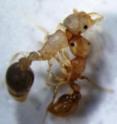The boys are bad: Older male ants single out younger rivals for death squad
Male Cardiocondyla obscurior ants are diphenic (either winged or wingless). New research published in BioMed Central's open access journal BMC Ecology demonstrates that the dominant wingless (ergatoid) male is able to identify potential rivals before they emerge from their pupae. Constant patrolling of the nest ensures that this male is able to bite or chemically tag rivals as soon as they emerge from their pupae. Chemically tagged ants are quickly destroyed by workers. When ants emerge from their pupae (eclosion) they are vulnerable to attack because their exoskeleton has not yet hardened to protect them and their mandibles are also too weak to bite an attacker. Researchers from University of Regensburg and IST Austria investigated the behaviour of male ergatoid C. obscurior ants in response to newly pupated males and females as well as their interaction with developing pupae.
It would be advantageous for newly emerged males to hide from attackers. However, while winged males use chemical female mimicry to avoid being detected, young ergatoid males are easily detected and attacked by older males. If the fight occurs during the first day after eclosion the older male will always win but once the younger male's exoskeleton hardens his chances of surviving rises to 14%. Nearly 50% of fights between older and two-day old males results in the death of both combatants.
In addition to biting the males also smeared each other with secretions from their anuses which encouraged worker aggression. The older males were more likely to chemically tag two-day olds than younger rivals (presumably recognising that they needed help to win the fight) however since both males end up being tagged they both suffer worker attacks. The winners of these fights smear more and are attacked less by workers. So although this tactic overall may provide an 'edge' it is a risky strategy.
Dr Sylvia Cremer, from IST Austria, who led this project commented, "Older ergatoid male ants are able to distinguish pupae containing females by their chemical scent from those containing males. Pupae containing males are often bitten while those containing females (or winged males disguised as females) elicit a mating response. However the chances of mistakenly killing a female or worker possibly prevents older males from attempting to completely destroy all rival males before they emerge from their pupae."
C. obscurior ants produce sexual females and ergatoid males throughout the year. In terms of colony survival this ensures that if the old dominant male dies there is a new male ready to replace him. The cost of producing a constant supply of ergatoid males is low compared to the cost of producing unfertilised females, and any killed males are recycled as food for the larvae.
Source: BioMed Central
Other sources
- The boys are bad: Older male ants single out younger rivals for death squadfrom Science DailyTue, 19 Jun 2012, 0:32:08 UTC
- The boys are bad: Older male ants single out younger rivals for death squadfrom Science DailySat, 16 Jun 2012, 2:30:24 UTC
- The boys are bad: Older male ants single out younger rivals for death squadfrom PhysorgFri, 15 Jun 2012, 0:00:50 UTC
